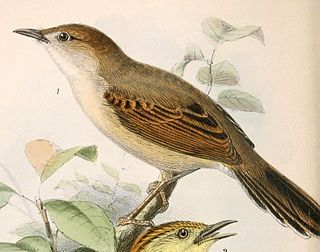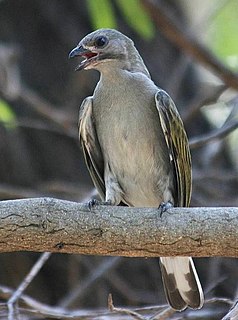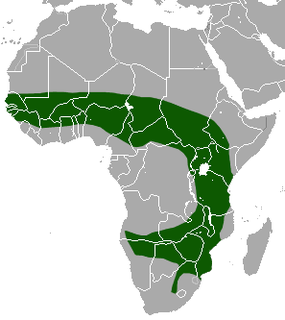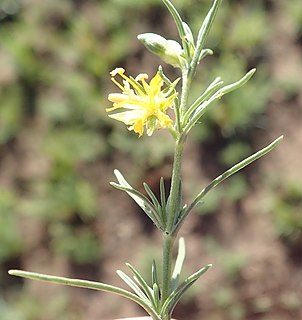The individual member states of the African Union (AU) coordinate foreign policy through this agency, in addition to conducting their own international relations on a state-by-state basis. The AU represents the interests of African peoples at large in intergovernmental organizations (IGO's); for instance, it is a permanent observer at the United Nations' General Assembly.
The Badminton Confederation Africa(BCA) is the governing body of badminton in Africa. It is one of the 5 continental bodies under the flag of the Badminton World Federation (BWF). It now has 42 member countries and 1 associate member.

The lesser blue-eared starling or lesser blue-eared glossy-starling is a species of starling in the family Sturnidae. It is found in Benin, Burkina Faso, Burundi, Cameroon, the Central African Republic, Chad, the Democratic Republic of the Congo, Eritrea, Ethiopia, Gambia, Ghana, Guinea, Guinea-Bissau, Ivory Coast, Kenya, Liberia, Malawi, Mali, Mozambique, Namibia, Nigeria, Senegal, Sierra Leone, South Sudan, Sudan, Tanzania, Togo, Uganda, Zambia, and Zimbabwe.

The singing cisticola is a species of bird in the family Cisticolidae. It is found in Benin, Burkina Faso, Burundi, Cameroon, Central African Republic, Chad, Democratic Republic of the Congo, Ivory Coast, Eritrea, Ethiopia, Gambia, Ghana, Guinea, Guinea-Bissau, Kenya, Liberia, Malawi, Mali, Mozambique, Niger, Nigeria, Rwanda, Senegal, Sierra Leone, Sudan, Tanzania, Togo, Uganda, Zambia, and Zimbabwe. Its natural habitats are subtropical or tropical dry forest and subtropical or tropical dry shrubland.

The white-breasted cuckooshrike is a species of bird in the family Campephagidae. It is found in Angola, Benin, Botswana, Burkina Faso, Burundi, Cameroon, Central African Republic, Democratic Republic of the Congo, Ivory Coast, Ethiopia, Gambia, Ghana, Guinea, Guinea-Bissau, Kenya, Malawi, Mali, Mauritania, Mozambique, Namibia, Nigeria, Rwanda, Senegal, Sierra Leone, South Africa, Sudan, Swaziland, Tanzania, Togo, Uganda, Zambia, and Zimbabwe. Its natural habitats are subtropical or tropical dry forest and dry savanna.

The lesser honeyguide is a species of bird in the family Indicatoridae.

The bicolored musk shrew is a species of mammal in the family Soricidae. It is found in Angola, Benin, Botswana, Burkina Faso, Burundi, Cameroon, Central African Republic, Chad, Democratic Republic of the Congo, Ivory Coast, Ethiopia, Gambia, Ghana, Guinea, Guinea-Bissau, Kenya, Lesotho, Malawi, Mali, Mauritania, Mozambique, Namibia, Niger, Nigeria, Rwanda, Senegal, Sierra Leone, South Africa, Sudan, Tanzania, Togo, Uganda, Zambia, and Zimbabwe. Its natural habitats are dry savanna, moist savanna, subtropical or tropical dry lowland grassland, and hot deserts.
Agriocnemis exilis is a species of damselfly in the family Coenagrionidae. It is found in Angola, Botswana, Burkina Faso, Cameroon, Central African Republic, Chad, Ivory Coast, Egypt, Ethiopia, Gambia, Ghana, Guinea, Kenya, Liberia, Madagascar, Malawi, Mauritius, Mozambique, Namibia, Nigeria, Réunion, Senegal, Sierra Leone, Somalia, South Africa, Tanzania, Togo, Uganda, Zambia, Zimbabwe, and possibly Burundi.

Vahlia is a genus of herbs and subshrubs that grow in Africa and the Indian subcontinent. There are at least five species.

Eublemma is a genus of moths of the family Erebidae described by Jacob Hübner in 1829.

Acraea egina, the elegant acraea, is a species of butterfly in the family Nymphalidae.

Deudorix lorisona, the coffee playboy, is a butterfly in the family Lycaenidae. It is found in Senegal, the Gambia, Guinea-Bissau, Guinea, Sierra Leone, Burkina Faso, Liberia, Ivory Coast, Ghana, Togo, Nigeria, Cameroon, Equatorial Guinea, São Tomé and Príncipe, Gabon, the Republic of the Congo, the Central African Republic, the Democratic Republic of the Congo, Sudan, Uganda, Ethiopia, Kenya, Burundi, Tanzania, Malawi, Zambia, Mozambique and Zimbabwe. The habitat consists of dense savanna and forests.

The African Forum for Agricultural Advisory Services (AFAAS), is a continental organization for strengthening Agricultural Extension and Advisory Services (AEAS) in Africa. It operates within the framework of the Comprehensive Africa Agriculture Development Programme (CAADP), a venture of the African Union in the New Partnership for Africa's Development (NEPAD). AFAAS is an autonomous subsidiary of the Forum for Agricultural Research in Africa (FARA).
This article lists the results of the Morocco national football team.
In 2011, the Economic Community of West African States (ECOWAS) adopted a Policy on Science and Technology (ECOPOST).
Science and technology in Tanzania describes developments and trends in higher education and science, technology and innovation policy and governance in the United Republic of Tanzania since the turn of the century.
Science and technology in Burkina Faso summarizes developments and trends in this field in Burkina Faso since 2010 and places them in their subregional context.
This is a list of the Ghana national football team results from 2010 to the present day.









